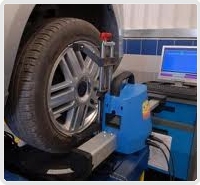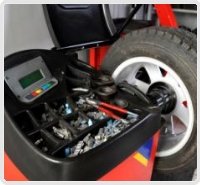|
Why is a Wheel Alignment Important
A Wheel alignment is a series of precise measurements and
adjustments to ensure your wheels are travelling parallel to
each other and that the tyres are making full tread contact to
the road. Wheel alignment prevents uneven tyre tread wear. Also
your vehicle pulling to one side while driving, and the steering
wheel feeling 'off centre'. It also maximizes tyre tread life and
contributes to safe and dependable vehicle steering and control.
feeling 'off centre'. It also maximizes tyre tread life and
contributes to safe and dependable vehicle steering and control.
What's included
- Road test to
determine system performance
- Inspection the
suspension and steering linkage components
- Check and adjustment
of tyre pressure as needed
- Adjustment of vehicle
alignment angles
- Front-end inspection
of steering and suspension components
- Work completed by a
'front end' licensed technician
When to have this done
- Every year or 15,000
km*.
- If abnormal tyre wear
is apparent
*This recommended service interval is based on industry average.
Please refer to your owner's manual.
Did you know?
Uneven tyre wear and incorrect alignment go hand-in-hand. Our
technicians can diagnose a problem with alignment and save a
potential costly tire repair. Alignment is the primary cause of
crooked steering wheel complaints.
Wheel Balance
Out-of-balance tires will cause a vehicle to vibrate at certain
speeds, usually over 50 km p/h. A tyre is out of balancewhen one
section of the tyre is heavier than the others. One ounce of
imbalance on a front tire is enough to cause a noticeable
vibration in the steering wheel at about 60 km.
To balance a wheel, our technician will mount it on a balancing
machine which spins the wheel to locate the heavier part. He
will then compensate for the heavy part by attaching a lead
weight on the opposite side. Many people are pleasantly
surprised at how smooth their car drives after balancing all
four wheels.
Most high quality tyres will hold their balance fairly well and
go out of balance very gradually. If you notice a vibration that
wasn't there the day before, it is possible that one of the lead
balancing weights fell off. If you feel the vibration mostly in
the steering wheel, the problem is most likely in a front wheel.
If the vibration is mostly in the seat, the problem is probably
in the rear.
When to have this done
- Every year or 15,000
km*.
- If abnormal tyre wear
is apparent
- If your steering
wheel viabrates while driving
- Every time you buy
new tyres
- Every time you get a
puncture repaired
*This recommended service interval is based on industry average.
Please refer to your owner's manual.
|